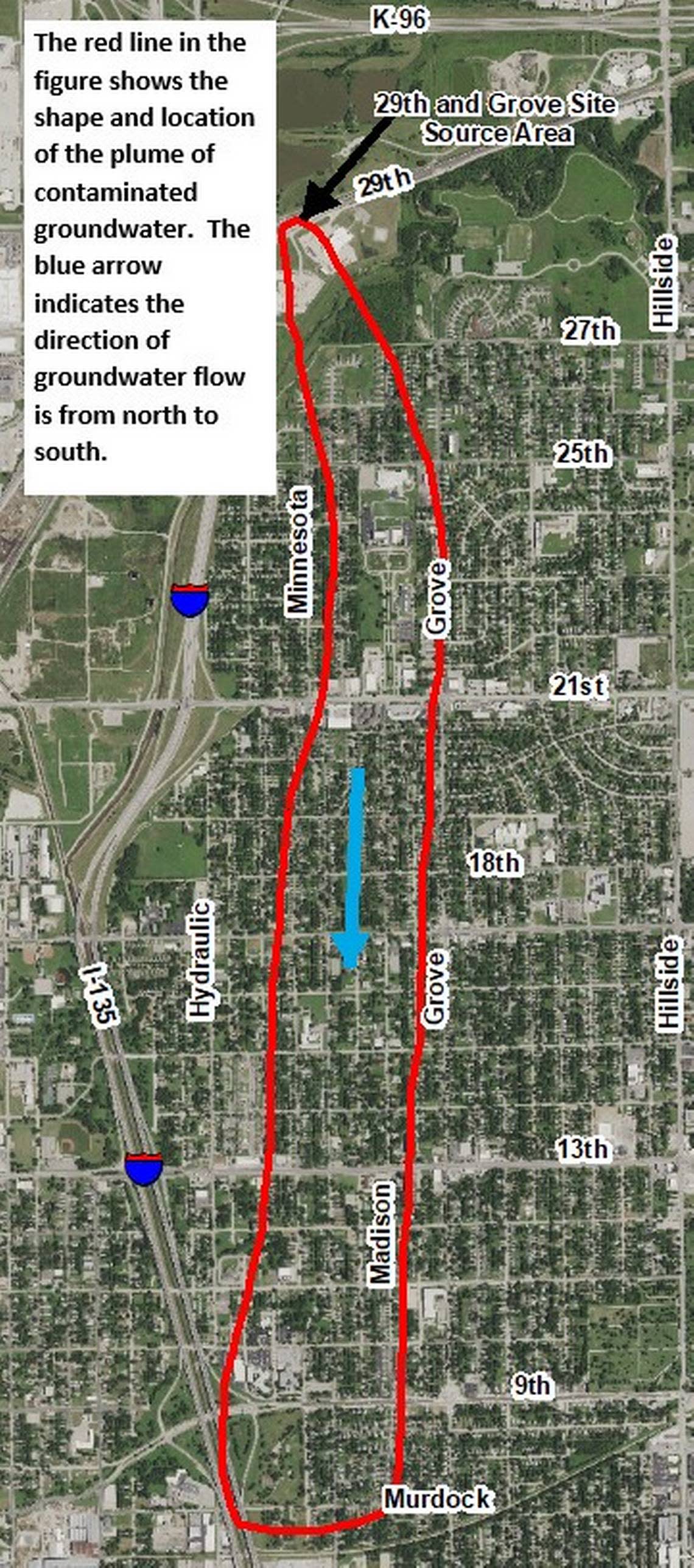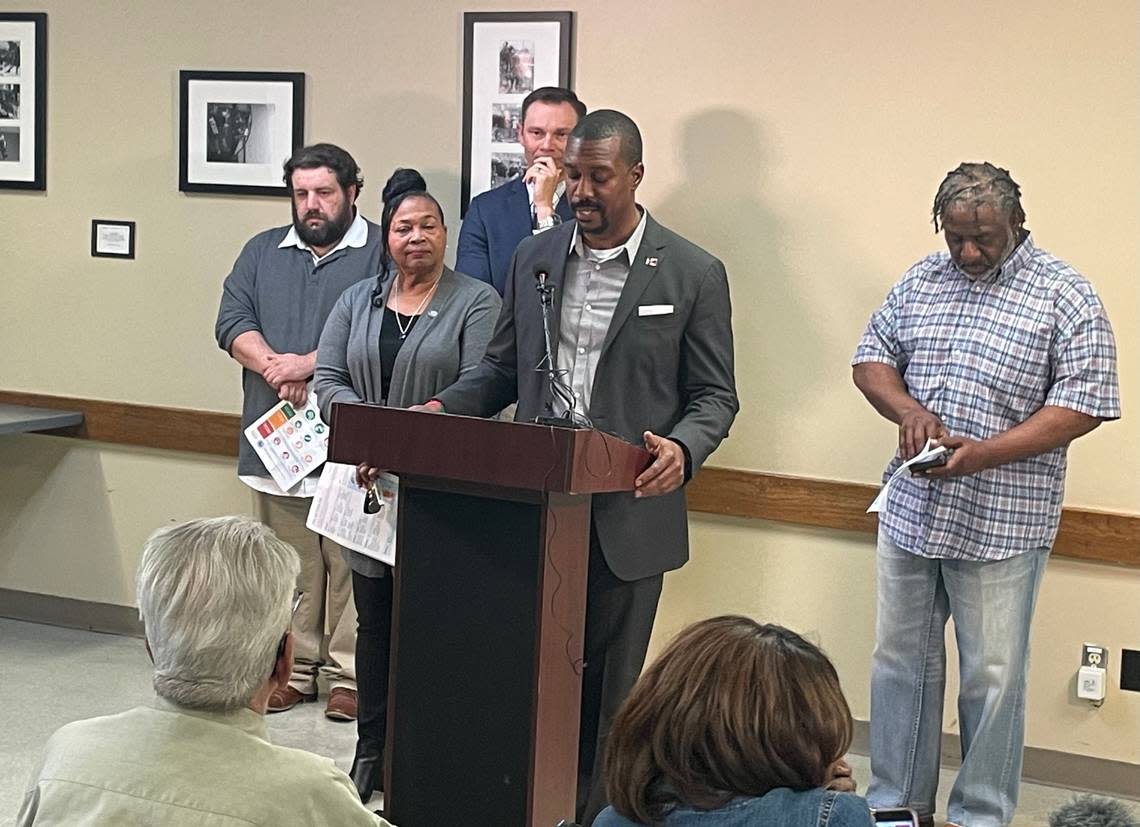Wichitans living near site of chemical spill found to have higher liver cancer rates
Wichitans living within the boundaries of the 29th and Grove groundwater contamination site are significantly more likely than other Kansans to have been diagnosed with liver cancer.
The finding came Friday as the Kansas Department of Health and Environment issued the first health study of the affected area since the chemical spill of trichloroethene (TCE) was identified in 1994 and linked to the Union Pacific Railroad rail yard south of K-96 between I-135 and Grove.
After hosting a forum about the contamination site in 2003, the state did not hold another public meeting about it until November 2022, when community members learned about the presence of TCE for the first time and asked for a health study to be conducted.
“This is really a systematic failure of communication. I don’t think there’s any other way to state it more clearly. This has been a failure,” Sedgwick County Commissioner Ryan Baty said Friday afternoon during a briefing with other local officials at the Atwater Neighborhood Resource Center.
The health study, which focused on the 2,793 addresses in the contaminated area, found a liver and biliary tree cancer diagnosis rate of 15.7 per 100,000 people compared with 6.4 and 8.0 diagnoses per 100,000 people in Kansas and Sedgwick County, respectively.
Among non-Hispanic Black residents, the diagnosis rate was 23.9 per 100,000. The plume of polluted groundwater runs for 2.9 miles from the rail yard site south to Murdock Avenue under several of northeast Wichita’s historically Black neighborhoods.

KDHE: No way to know cause of higher cancer rates
State Epidemiologist and Environmental Health Officer Dr. Farah Ahmed told news organizations Friday that there’s no way to know definitively if TCE is responsible for the outsized number of liver cancer diagnoses.
“The study can only really report on whether an increase was observed, not the cause of the increase,” Ahmed said.
“There are a lot of different reasons why someone might be exposed to specific contaminants and why one person might have a health effect and another person might not.”
According to the U.S. Environmental Protection Agency, TCE can cause cancer in humans — “especially kidney cancer and possibly liver cancer and non-Hodgkin lymphoma.”
“Exposure to TCE does not mean you will get cancer, however, your chance of getting cancer will be increased,” the Centers for Disease Control and Prevention website states. “Your chance, or risk, of getting cancer goes up with how much, how frequent, and how long your exposures have been.”
“It’s really impossible to quantify how much exposure might have actually happened,” Ahmed said.
According to the EPA, water is contaminated if it contains more than 5 parts per billion of TCE. Two thirds of the 66 water quality tests conducted in May 2021 — 40 to 50 years after the chemical spill — found samples with higher-than-acceptable levels, including samples of as much as 823 TCE parts per billion.
Local officials were critical of KDHE’s assessment.
“What the doctors and what the state would try to tell us is that there’s no causation” between the contamination and increased liver cancer rates, Baty said.
“When you release information after 30 years of bad communication and you don’t back this information up with resources and better communication strategies, what the people in this community are left with are questions, fears.”
No KDHE representative was present for the Friday briefing. The agency released its health study in a press release earlier in the day.
Free cancer screenings sought
Residents in the affected area are being asked to complete a community health assessment and spread the word to others who have lived on top of the contamination site since 1970, the earliest experts estimate the spill could have taken place. The health assessment can be filled out online through a Google form or in person at the Atwater resource center.
Wichita City Council member Brandon Johnson said the city and county are working to secure free cancer screenings for residents and former residents of the affected area.
“There’s three clinics over there. I’ve talked to the heads of those clinics and I’ve also reached out to some of our other medical providers and asked, one, ‘What does the screening look like?’ We’ve been asking about cost so we can try to get a budget together,” Johnson said.
Local officials said they would like to see Union Pacific contribute to the cancer screening fund. A representative for the railroad could not be reached for comment Friday evening.
The railroad is already on the hook to pay for a $13.9 million cleanup plan outlined in KDHE’s final corrective action report for the 29th and Grove site, which was issued in February. Remediation efforts have been underway since 2004.
Johnson said Union Pacific is expected to hold a community forum in conjunction with local officials in the next 60 to 90 days.
The health study also reviewed rates of other health conditions, including cancers (kidney and renal pelvis, urinary bladder, myeloma, and lymphomas) as well as birth defects.
The only other higher-than-usual rate was for low birth weights for infants born to families in the affected area. The study found low birth weight rates of between 12% and 21% — higher than the rates in Wichita, Sedgwick County and Kansas of between 7% and 9%. The study notes that low birth weight rates in the affected area decreased from 2000 to 2021.
Possible TCE exposure
According to the KDHE report, all but one of the nearly 2,800 properties in the contaminated area were connected to city water before the spill is believed to have occurred, meaning it’s unlikely people would have drank directly from contaminated groundwater wells. But there are other risk factors for TCE exposure, which occurs when a person breathes, ingests or touches the chemical.
“Filling a pool with a contaminated lawn and garden well could expose a person who swam in the pool or drank the pool water,” the report states. “Or, if the contaminated lawn and garden well was used for a sprinkler system, individuals may be exposed by breathing in small droplets of contaminated water.”
A number of meeting attendees voiced concerns about their possible exposure playing in puddles and contaminated soil as children.
“I grew up in that neighborhood. I played as a child back in that area,” state Rep. Ford Carr said, referring to the area surrounding Dr. Glen Dey Park, which was identified as the likely site of the spill. “I implore our city officials to post signs now, which it’s late but it’s not too late.”
The site of the old rail yard is just north of the park.
“At the rear end of [the park] are football fields that are frequented by the little league football teams, and then behind that is an uncultivated area where many children including myself have spent many many days, many hours playing in that area,” Carr said.

Former City Council member Lavonta Williams said there’s no excuse for not having done more in the decades since the contamination was discovered to ensure residents’ safety and inform them of risk factors. She said KDHE has exhibited a lack of compassion toward the people affected by the pollution.
“This, to me, is an environmental injustice. That’s what it comes down to,” Williams said.
“We talk as if it’s just the groundwater, and it’s not,” said Aujanae Bennett, president of the Northeast Millair Neighborhood Association. “It’s also the vapors that are getting into our edifices, that are getting into our schools.”
Gordon Parks Academy on East 25th Street was built in the contaminated area and opened in 2008, more than a decade after contamination was first identified. KDHE has said it plans to do more extensive vapor testing in the area.
KDHE advises that although it’s unsafe to play in a hose or sprinkler attached to well water or walk barefoot on soil that is wet with well water, it is safe to water lawns and gardens and eat food grown in a garden with well water, as long as contaminated soil is first washed off.
“With all the lack of information that we have right now, I don’t trust that,” Baty said.
“Although it is stated that it’s safe that you can use well water to water your lawns, I personally want to encourage you not to because you should not have contact with that water,” Johnson said.
KDHE told officials that there are more than 200 active contamination sites in Sedgwick County.
“Most people aren’t aware of these things,” Baty said. “And most of these sites are just like what we see here at 29th and Grove. The people that it’s impacting and it’s happening beneath their feet are unaware of it.”
